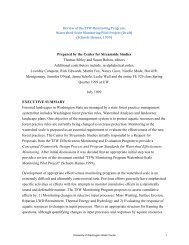Copyright 2012 Aileen M. Echiverri-Cohen - University of Washington
Copyright 2012 Aileen M. Echiverri-Cohen - University of Washington
Copyright 2012 Aileen M. Echiverri-Cohen - University of Washington
Create successful ePaper yourself
Turn your PDF publications into a flip-book with our unique Google optimized e-Paper software.
Sheehan Disability Scale (SDS; Sheehan, 1986) assesses disruption caused by symptoms<br />
in work, social activities, and home life. SDS uses an 11-point scale to evaluate disability in<br />
each <strong>of</strong> these three areas, ranging from 0 (not at all) to 10 (very severely). A global functional<br />
impairment score reflecting total impairment in work, social, and home functioning was used.<br />
The scale shows adequate reliability and construct validity (Leon, Shear, Portera, & Klerman,<br />
1992).<br />
Shipley Institute <strong>of</strong> Living Scale (Shipley, 1967) is a 60-item, self-administered test that<br />
assesses cognitive functioning in areas <strong>of</strong> verbal intelligence and abstract reasoning ability.<br />
Scores from the verbal intelligence and abstract reasoning subscales yield a composite score for<br />
the full scale (Paulson & Lin, 1970). The composite score <strong>of</strong> the two subscales was used to<br />
assess the effects <strong>of</strong> general cognitive ability. The measure shows good convergent validity with<br />
the Weschler Adult Intelligence Scale, (Kaufman, 1990).<br />
Materials<br />
Attentional blink. To provide a behavioral measure <strong>of</strong> temporal inhibition, a visual AB<br />
task was used (Raymond et al., 1992). Specifically, AB was made up <strong>of</strong> sequences with one or<br />
two visual targets (T) embedded in a stream <strong>of</strong> 16 to 20 distractors (D), referred to as rapid serial<br />
visual presentation (RSVP). The target set (T1, T2) consisted <strong>of</strong> letters (ACEJKRTY), and the<br />
distractor set consisted <strong>of</strong> numerals (23456789). AB was assessed using dual target trials that<br />
involved identification <strong>of</strong> two targets, where T1 was separated from T2 by 1, 2, 3, 4, or 5 serial<br />
positions, which was defined as the lag length (L1 - L5). Lag length was defined as the interval<br />
with 1 to 4 distractors separating a target from a distractor.<br />
AB presentation was controlled by Eprime s<strong>of</strong>tware v 1.0 (Psychology S<strong>of</strong>tware Tools,<br />
Inc.) and presented on a 17-inch Dell monitor. All stimuli were presented in size 48 Times New<br />
21
















